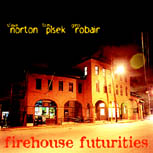
Norton/Plsek/Robair Trio at Tufts University’s WMFO radio
station in Medford, Massachusetts on February 4th, 1995 and a
long distance recording assembled using an adaptation of the
“exquisite corpse” method.
This is a cooperative release with Rastascan Records of
San Leandro, California.
[order] [CD cover art] [recordings]